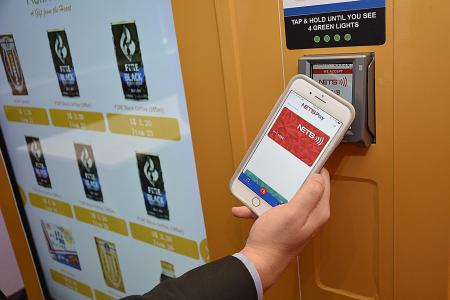Cashless payments must be painless to succeed
That is key for widespread acceptance of mobile payments and digital wallets by consumers and merchants
The launch of NetsPay in Singapore last week will give a big push to Singapore's drive to become a cashless society.
The Republic's leading payment network, backed by the three local banking groups, has the largest merchant and user base, and a 32-year track record of serving one in three people for everyday purchases.
Prime Minister Lee Hsien Loong, during his National Day Rally speech on Aug 20, noted the need to "simplify and integrate" the many different payment systems now in use, which is confusing consumers.
While the perception seems to be that the Republic is lagging behind China in digital payments, cashless payments have been a popular mode of payment for consumers in Singapore for many years.
They simply take other forms - namely cheques, debit cards and credit cards. Singapore, in fact, has one of the highest usage of credit cards in Asia.
Singapore's efficient regulatory system, advanced mobile phone infrastructure and well developed financial services industry, have long facilitated cashless transactions.
Its mobile readiness has been ranked ahead of the United States and China.
A 2012 global Mastercard survey analysed 34 countries and their readiness to use three types of mobile payments: person to person, mobile web commerce and mobile contactless payments at the point of sale.
While no two markets are the same, Mastercard noted that consumer readiness is the critical success factor to drive mobile payments adoption around the globe.
The report noted that Singapore's overall score of 45.6 (index average is 33.2) and first place in the MasterCard Mobile Payments Readiness Index, can be attributed to its strengths in several areas.
However, the infrastructure has yet to catch up and consumers' willingness to adopt mobile payments and current frequency of use lagged behind some less developed global economies.
Where Singapore lags is in mobile payments and the use of digital wallets. MasterCard's 2016 Mobile Shopping Survey showed the Republic fell behind China and India in embracing digital wallets in a region where one in five consumers are already using them.
So what are the key factors for widespread acceptance of mobile payments and digital wallets by customers and merchants?
We at Dynatrace believe it all boils down to two words: customer experience.
What happens in the customer journey as he/she tries to transact on an app or e-commerce website is critical to mass adoption of the technology. The smoother the journey, the faster the adoption.
Our years of experience in monitoring the performance of apps for a wide range of industries tell us that a customer will abandon or not recommend a mobile app if he or she has problems accessing the site, or waits more than three seconds for a page to download.
ACCUSTOMED
With Singaporeans so accustomed to the efficiency of cash, debit and credit cards, all enhanced by the ubiquity of ATMs across the island, any new digital payment system will have to be just as efficient if not more so before large numbers of people will want to switch.
Consumers also do not want to carry another credit card or device and merchants do not want more Point-of Sale (POS) machines on their already cluttered check-out counters. Applications like Apple Pay, Samsung Pay and PayNow are able to address some of these issues.
Whichever operators of applications eventually emerge as the main providers, mobile devices will be a key component of their strategy and the ability to harness the complexity of cloud and mobile devices will be vital.
Factors like the number of steps to complete the transactions, the speed in which transactions can be processed and understanding users' behaviour for appropriate marketing tactics will all play a part in adoption.
Infrastructure providers like the companies that run our public transport system or our telecommunications networks have learnt a performance-first strategy and a proactive approach are vital to ensure all the moving parts of their platforms are operating at optimal performance level. Or they risk incurring consumers' wrath and severe reputational damage.
The cashless payment operators are no different.
They should not think that managing users' devices, merchants POS, payment gateways, telco's availability, cyber security etc, is a walk in the park. But if they have as their mantra "the consumer is king", they will do well.
The writer is regional director, Asean, at Dynatrace. This article was published in The Business Times yesterday.
Get The New Paper on your phone with the free TNP app. Download from the Apple App Store or Google Play Store now



